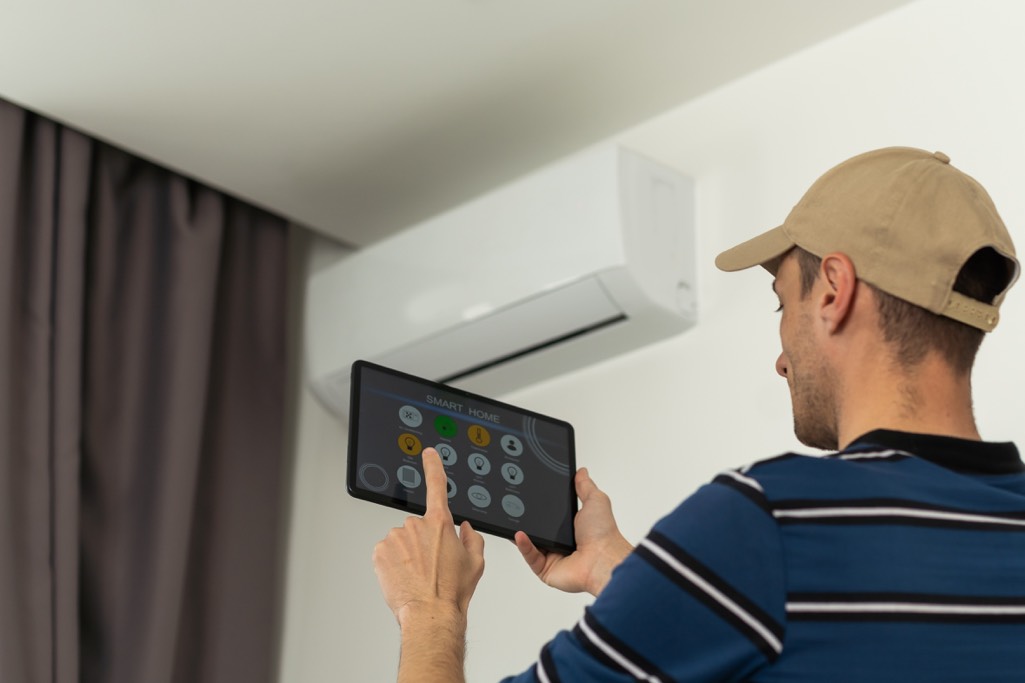Heat pump sizing chart
The basic rule of thumb when figuring out what size heat pump you’ll need is to allow 50 Watts (0.05KW) per 1m2 of floor space. You can then use a heat pump sizing chart to add or subtract to this figure.
If you’re looking for a sizing chart then you can find one below. The chart works on surface area and is adjusted for the age and energy performance of your home.
Do be careful however. A heat pump sizing chart should only be used as a guide. The most important thing to do when considering heat pump installation is to get a heat loss survey done by a qualified HVAC professional.
The different sizes of heat pump
The output of heat pumps is measured in Kilowatts (KW). A typical air source heat pump in the UK will range between 5KW – 16KW. As we said, you will need about 50 Watts (0.05KW) per 1m2 of floor space.
However, you will have to adjust the required output to take into account your particular type of home (more on this later).
The outdoor unit of the heat pump is likely to be between 1 and 1.5 meters high (around 3-5 feet) with a width of around 0.5 to 1 meter (around 2-3 feet). It is likely to weigh anything up to 100kg (220lb).
Using a sizing chart to choose the right size heat pump
Heat pump power is usually quoted at standard of 7°C/35°C. This means that a 10KW heat pump will deliver 10KW of heat energy when the temperature outside is 7°C and the flow temperature inside of the heat pump is 35°C.
You might also see power expressed at British Thermal Units (number of BTUs). These units are very popular in the USA as well as the UK. To convert kW to BTU rating you can multiply by 3141.
The correct size of heat pump for your house will be affected by several factors. Let’s look at each one in turn
Property size
It stands to reason that if the surface area your property is larger it will require more heat to reach a comfortable temperature.
We said that you’ll need about 50W per 1 square meters (107 square feet) of floor space. So for a 150M2 (1605 sq ft) home this will be around 7.5KW.
(150 x 50) = 7500W or 7.5KW or 23,557 BTU heat pump
But as we’ll see this is a very crude calculation. It does not take into account ceiling height (high ceilings mean bigger overall heating load requirements). It will also change a lot in real life according to some of the various factors below:
The age of your property
We’ve written about this extensively elsewhere on the site. As well as the square footage of your home, the age of your house is going to be one of the key factors that determine the right sized heat pump.
Around 20% of the housing stock in the UK is built pre 1919 with poor insulation levels. Unless you have upgrades, this means, single skin brick walls, leaky single glazed windows and drafty doors. Older homes like this can multiply your heating requirements by up to 3 times.
If you live in an older, less energy efficient home you may have to do some extensive modifications before you install any type of heat pump, otherwise you will simply be throwing money away. Heat pumps work at a lower flow rate temperature and it’s very important that your house retains the heat which is generated.
We’ve written about this on the site and we encourage to you to read some of our other articles. Another thing you can do is to reduce the output of your gas boiler down to 50°C to see how your home with the reduced flow temperature of a heat pump.
On the flip side, if you live in a modern, energy efficient home, you’ll be able to reduce that 50W per 1m2 figure.
Your heating needs
Do you take a lot of baths? Or do you mainly take showers. What indoor temperature are you used to? Do you like to heat your house to 22°C or are you comfortable with 19°C and a sweater?
You don’t want to under spec the heat pump in your home. But you do want to make sure you don’t overspec it either. More on this below.
Occupancy patterns
You also need to consider the people living with you and how much hot water and heat they will need.
An elderly couple living in a 4 bed property will have very different needs to a young family. Similarly if you are at work all day, you will require less heat than someone that works at home.
The local climate
Clearly if you live in a part of the country with very cold weather (or a very cold winter season) you will need to make sure your heat pump can deal with it.
Heat pumps are perfectly capable of dealing with temperatures as low as -20°C (-4°F). But at these low temperatures they might not be the most efficient way of heating your home.
Heat pumps designed for cold climates normally have an auxiliary heating system which kicks in when it gets really cold. This will reduce the seasonal energy efficiency ratio of the system considerably and drive up your energy costs.
Many homeowners who live in very cold climates have an alternative heating system to use in very cold weather such as gas boiler (gas furnace). This can be a good idea if you want to use your heat pump with maximum efficiency.
Heat pump size calculator (heat pump sizing chart)
You should take any heat pump sizing chart you find on the internet with a large pinch of salt, but we like this one from the guys over at Heat Geeks.
It’s very useful for giving a general idea of load calculation. But as with all online calculators please make sure you use this as a guide only.
| Type of property | Watts per M2 |
| Passive haus | 2-10 |
| Eco/low carbon home | 10-20 |
| Recent new build (post 2006) | 20-40 |
| Pre 2006 new build or recent renovation | 30-50 |
| Renovated properties with cavity wall insulation and over 75mm loft insulation | 40-65 |
| Victorian houses, mix of single and double glazing, with 55-75mm loft insulation | 65-85 |
| Victorian or older, single glazed, no loft insulation | 95-110 |
| If the property is going to be on/off | add 10% |
| If intermittently heated, i.e. a holiday home | add 20% |
Always get a full heat loss survey
We can’t say this enough. Working out what size of heat pump you will need is a complicated job which requires the expertise of HVAC professionals. Before starting any kind of installation process you must get a full survey done by a professional heat pump installer.
During the full survey, the engineer should measure every radiator in your home as well as the insulation performance of all of your windows and doors. They will also examine how your home is constructed and work out what the heat loss is likely to be through external walls and the loft.
This process will take at least a few hours. If the engineer finishes in less time than this we advise you to cancel the contract.
In the US, the engineer will often run a Manual J calculation based on the square footage of the room.
For more advice on how to find a good heat pump installer please check out this article.
Don’t get a heat pump system that’s undersized or oversized
It’s very important to get the right heat pump for your home – not too big or too small. An undersized heat pump will have to work very hard to get your home to a comfortable temperature. This is likely to put a lot of strain on the parts and lead to larger maintenance bills.
An oversized unit will be switching on and off more times than it’s designed for (short cycling). This risks burning out the motor, or the compressor and could mean the lifespan of your heat pump is reduced.
Are you thinking about heat pump installation?
If you’re looking for a heat pump sizing chart, it’s a good bet that you’re thinking about installing a heat pump. The most common question we hear at WeLoveHeatPumps is around the cost. We have examined this in detail for both air source and ground source heat pumps.
Did you also know there are a number of Government grants in the UK that can save you up to £7,500 on the cost of a new heat pump installation? Please check out our guide to funding for more information.

